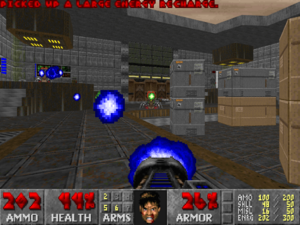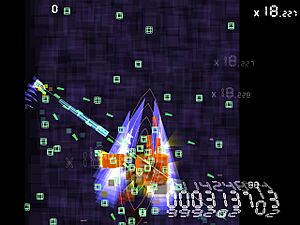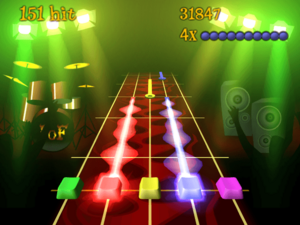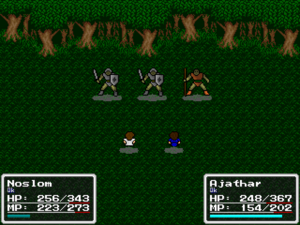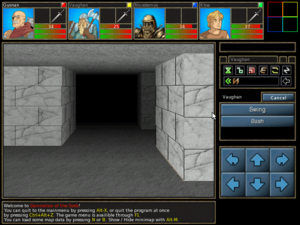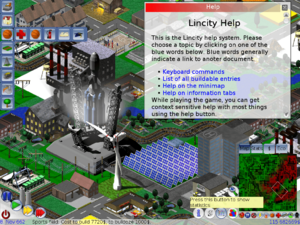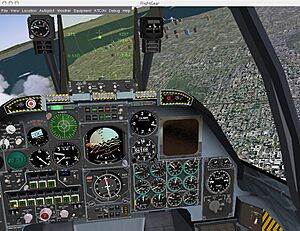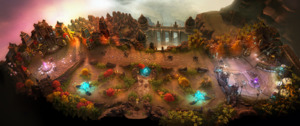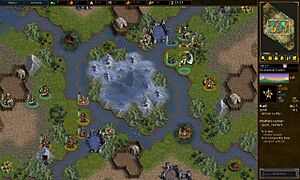List of video game genres facts for kids
A video game genre is a way to group games that have similar ways of playing. It's not usually about the story or where the game takes place, but about how you, the player, interact with the game. For example, a first-person shooter is still a shooter whether it's in space or the Old West, as long as you see through the character's eyes (first-person) and shoot things.
Games can fit into many groups, leading to smaller, more specific groups called subgenres. For instance, an action game can be a platform game or a fighting game. Some games, especially those played on browsers or phones, can even belong to several genres at once!
Here's a list of the most common video game genres, with simple descriptions for each one and its main subgenres.
Contents
- Action Games: Fast-Paced Challenges
- Action-Adventure: Explore and Fight
- Adventure Games: Puzzles and Stories
- Puzzle Games: Brain Teasers
- Breakout Clones: Hitting Blocks
- Logical Puzzle Games: Consistent Rules
- Trial-and-Error / Exploration Puzzles: Discovering Solutions
- Hidden Object Games: Find the Items
- Reveal the Picture Games: Uncovering Images
- Tile-Matching Games: Lining Up Tiles
- Traditional Puzzle Games: Digital Classics
- Puzzle-Platformers: Jumping and Thinking
- Role-Playing Games (RPGs): Grow Your Character
- Simulation Games: Living a Virtual Life
- Strategy Games: Think and Plan
- 4X Games: Explore, Expand, Exploit, Exterminate
- Artillery Games: Tank Battles
- Auto Battlers (Auto Chess): Strategic Placement
- MOBAs: Team Battles Online
- Real-Time Strategy (RTS): Constant Action
- Real-Time Tactics (RTT): Battlefield Control
- Tower Defense: Protecting Your Base
- Turn-Based Strategy (TBS): Taking Turns to Plan
- Turn-Based Tactics (TBT): Detailed Combat Planning
- Wargames: Simulating Battles
- Grand Strategy Wargames: Controlling Nations
- Sports Games: Virtual Athletics
- MMOs: Massive Online Worlds
- Other Cool Game Types
- Board and Card Games: Digital Versions of Classics
- Casino Games: Virtual Gambling
- Digital Collectible Card Games: Online Card Battles
- Digital Therapeutic Video Games: Games for Your Brain
- Gacha Games: Random Rewards
- Horror Games: Spooky Stories
- Idle Games: Play Themselves
- Party Games: Fun with Friends
- Photography Games: Taking Pictures
- Social Deduction Games: Find the Imposter
- Trivia Games: Test Your Knowledge
- Typing Games: Keyboard Skills
- Video Game Genres by Purpose
- Advergames: Games That Advertise
- Art Games: Unique and Beautiful
- Casual Games: Quick and Easy Fun
- Christian Games: Faith-Based Fun
- Educational Games: Learn While You Play
- Esports Games: Professional Gaming
- Exergames (Fitness Games): Exercise and Play
- Personalized Games: Made Just for You
- Serious Games: Games with a Purpose
- Live Interactive Games: Playing with Streamers
- Sandbox and Open World Games: Freedom to Play
- Images for kids
- See Also
Action Games: Fast-Paced Challenges
Action games are all about physical challenges. They need you to have good hand-eye coordination and quick reactions. You control most of the action. Many of the first video games were action games, and it's still a huge group today, covering any game with physical challenges.
Action games have many subgenres. Platform games and fighting games are very well-known. Shooter games have also been super popular since the 1990s. Action games often involve quick, reflex-based gameplay.
Platformers: Jumping and Climbing Fun
Platform games (or platformers) mostly involve jumping and climbing to move around the game world. You might avoid enemies or just solve jumping puzzles. In these games, your character can usually jump very high, and you can often control their movement in the air. The game levels often have lots of uneven ground to jump onto or fall from.
Donkey Kong (1981) was one of the first famous platformers. Super Mario Bros. (1985) is another classic platformer and one of the best-selling games ever!
Shooter Games: Aim and Fire!
In shooter games, you use weapons to fight from a distance. Most shooters involve violence, where you use weapons to hurt opponents. But some, like Splatoon, have non-violent goals.
Shooters can also be grouped by how you see the game. In first-person shooters, you see the world through your character's eyes. You often see a screen showing important info like your health. In third-person shooters, you see your character's whole body and the environment from a bit of a distance. Some games let you switch between both views.
Hero shooters are multiplayer games where you pick special "hero" characters. Each hero has unique powers or weapons. These games really encourage teamwork, as players need to pick heroes that work well together. You can change how your heroes look, but it doesn't affect gameplay. Popular hero shooters include Overwatch and Apex Legends.
Light gun shooters use a gun-shaped controller. These "light guns" work using a light sensor. This technology has been around since the 1920s for shooting games, even before video games existed!
Shoot 'em ups put you, often flying a vehicle, against huge waves of enemies. You're always moving and must attack while dodging enemy attacks and obstacles.
Since the 1990s, shooters, especially first-person ones, have been super successful. Wolfenstein 3D (1992) helped create many ideas used in later shooters. Doom (1993) is considered one of the most important games ever. Other big shooter series include Half-Life and Call of Duty.
Fighting Games: Close Combat Action
Fighting games are all about close-up battles, usually one-on-one or against a few strong opponents. They often involve violent, over-the-top unarmed attacks. Most fighting games have many characters to choose from and a competitive multiplayer mode. While many focus on hand-to-hand combat, some, like Soulcalibur, use weapons. Many fighting games use moves inspired by martial arts. Fighting games were very popular until the late 1990s, but classics like Mortal Kombat, Street Fighter, and Super Smash Bros. are still huge today.
Beat 'em Up Games: Fighting Crowds
Beat 'em ups (or brawlers) are similar to fighting games but different. While both have close combat, beat 'em ups make you fight large groups of enemies instead of just a few. They often mix in ideas from other action games. Multiplayer in beat 'em ups is usually about working together, not competing. They became less popular when fighting games arrived but 3D beat 'em ups have kept the genre going. Hack and slash is a type of beat 'em up that uses weapons.
Stealth Games: Sneak and Hide
Stealth games focus on sneaking around and avoiding enemies, rather than fighting them directly. Games like the Metal Gear series are good examples. In these games, you can usually still fight loudly, but you're often punished for it. In other games, like Dishonored, you can choose to use stealth or not, but stealth is often encouraged because you're weaker than many enemies. Just having stealth in a game doesn't make it a stealth game. For example, Skyrim has stealth skills, but you can still fight your way through most areas.
The first stealth game was Manbiki Shounen (Shoplifting Boy), released in 1979. Hideo Kojima's Metal Gear was the first big stealth game, selling over a million copies. Metal Gear Solid was the first 3D stealth game and helped make the genre popular.
Survival Games: Staying Alive
Survival games start you with almost nothing in a dangerous, open world. You need to find resources, craft tools, weapons, and shelter to stay alive as long as you can. Many of these games have worlds that are created randomly, and they often don't have a clear ending. They can sometimes feel like survival horror games, especially if they're set during a zombie apocalypse or similar scary event.
Rhythm Games: Music and Timing
A rhythm game challenges your sense of rhythm. This genre includes dance games like Dance Dance Revolution and music games like Rock Band and Guitar Hero. In these games, you press buttons at exactly the right time. The game shows you which buttons to press, and you get points for being accurate and in sync with the music.
PaRappa the Rapper was an early and important rhythm game. Other popular rhythm games include Dance Dance Revolution, Project Diva, and Taiko no Tatsujin.
Battle Royale Games: Last One Standing
A battle royale game mixes survival, exploration, and scavenging with "last person standing" gameplay. Many players start with very little gear. They must search for weapons and armor and try to defeat other players. At the same time, a safe area on the map shrinks over time, forcing players closer together. The last player or team alive wins! Famous battle royale games include PlayerUnknown's Battlegrounds, Fortnite Battle Royale, and Apex Legends.
Action-Adventure: Explore and Fight
Action-adventure games combine parts of action games and adventure games. They often have big challenges that need a special item or tool you found earlier. They also have many smaller obstacles that require action game skills to get past. These games usually focus on exploring, finding items, solving simple puzzles, and fighting. Sometimes, "action-adventure" is used for games that don't quite fit into other clear genres. Because they are so common on consoles, modern players sometimes just call them "adventure games."
One of the first action-adventure games was Adventure (1980) for the Atari 2600. It was inspired by the text-based game Colossal Cave Adventure. To make it work on a console with just a joystick, the designer added action elements.
The genre really took off with The Legend of Zelda (1986). This game was a hit because it mixed exploration, puzzles, action, and a simple way to make your character stronger. It was also one of the first games to offer an open world where you could explore freely. Zelda has remained a very popular action-adventure series.
Survival Horror: Spooky Challenges
Survival horror games focus on making you feel scared using classic horror elements like scary atmospheres, monsters, and gore. A key part of many of these games is having very little ammunition or weapons that break easily. Famous examples include Silent Hill and Resident Evil.
The first survival horror game was AX-2: Uchuu Yusousen Nostromo, released in Japan in 1981.
Metroidvania: Exploring Interconnected Worlds
Metroidvania games are a type of platformer named after the famous Metroid and Castlevania series. They feature large, connected maps that you can explore. However, some areas are blocked until you find special tools, weapons, or abilities. Getting these upgrades also helps you beat tougher enemies and find secret areas. Metroidvanias usually aren't linear, meaning you often have to go back to old areas once you have new powers.
Adventure Games: Puzzles and Stories
Adventure games were some of the earliest games, starting with the text-based Colossal Cave Adventure in the 1970s. This game was simply called "Adventure," and it gave the genre its name. Over time, graphics were added, and the way you played changed.
Unlike adventure movies, adventure games are not defined by their story. Instead, they are about playing without needing quick reflexes or action. They usually ask you to solve puzzles by talking to people or interacting with the environment, often in a peaceful way. This genre tends to avoid action elements, except for small mini-games.
Because they don't put much pressure on you with action or time limits, adventure games can appeal to people who don't usually play video games. The genre was most popular with the release of Myst in 1993, which became the best-selling PC game at the time. Its simple point-and-click controls, detailed worlds, and relaxed pace made it easy to play. Myst also inspired many similar games.
In the late 1990s, adventure games became less popular. But they've seen a small comeback, especially on Nintendo consoles.
Text Adventures: Typing Your Way Through Stories
The first adventure games were text adventures, also known as interactive fiction. Games like the Zork series from the late 1970s and early 1980s let you type commands like "get rope" or "go west." The computer would then describe what happened. A lot of effort went into making the computer understand what you typed.
Graphic Adventures: Pictures and Pointing
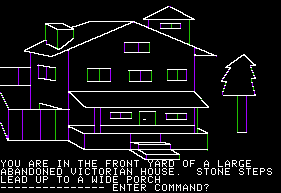
As computers got better graphics, adventure games started to use pictures instead of just text. Early graphic adventure games still used text commands. But then, with the rise of mice, "point-and-click" adventure games became popular. Now, you could just click on an icon, like a hand, and then on an object, like a rope, to pick it up.
Visual Novels: Reading a Story with Pictures
A visual novel is a game with mostly still pictures, often in an anime style. As the name suggests, they are like interactive books or plays. Many visual novels let you make choices that affect the story and can lead to different endings. They are very popular in Japan. Some popular visual novels released in other countries include the Ace Attorney series.
Interactive Movies: Watching and Choosing
The interactive movie genre appeared with laserdiscs. An interactive movie has pre-filmed video clips (like cartoons or real actors). You control some of the main character's actions. For example, if your character is in danger, you choose what they do next. In these games, your main job is to pick the right action the game designers want you to make. Elements from interactive movies are now often used in game cutscenes as Quick Time Events, where you have to press a button quickly to react.
Real-time 3D Adventures: Modern Exploration
Around the late 1990s, real-time 3D adventure games started to appear. These games added elements from action games, like free movement and realistic physics. Examples include Shenmue and the Yakuza franchise.
Puzzle games are for those who love to use their brain and enjoy solving tricky problems. They can be simple versions of real-world puzzles like Sudoku or complex games designed for a video game world. They test your problem-solving skills, including logic, finding patterns, and completing sequences. Puzzle games are very popular, especially on phones, where casual games and tile-matching games are a huge hit.
Puzzle games focus on logical and thinking challenges, though some also need quick thinking. While many action and adventure games have puzzles, a true puzzle game makes solving puzzles its main goal. This genre sometimes mixes with educational games.
Instead of just giving you random puzzles, puzzle games usually offer a series of related puzzles that are variations on a single idea. This idea might involve recognizing patterns, using logic, or understanding a process. These games often have rules where you move game pieces on a grid or other space. You have to figure out clues to win, which then lets you move to the next, usually harder, level.
Breakout Clones: Hitting Blocks
Breakout clone games (also called block-breaking or ball-and-paddle games) are a type of puzzle game. They are named after the way you control a block (called a "paddle") that hits a ball towards different objects like colored tiles or indestructible bricks. Breakout (1976) and Arkanoid (1986) are classic examples.
Logical Puzzle Games: Consistent Rules
Logical puzzle games follow clear rules and systems throughout the whole game. Solving them usually requires you to use deductive reasoning skills, meaning you figure things out based on what you already know.
Physics Games: Using the World's Rules

A physics game is a type of logical puzzle game where you must use the game's physics and environment to solve each puzzle. Physics games use consistent physics to make the challenges harder. This genre is very popular in online flash games and mobile games. Teachers have even used these games to show how physics works.
Popular physics-based puzzle games include Portal, World of Goo, and Angry Birds.
Programming Games: Building Instructions
A programming game is a computer game where you have little or no direct control over the game's characters. Instead, you write a computer program or script using a special language to tell the characters (like robots or tanks) what to do. In SpaceChem, for example, you design circuits to create molecules.
Examples include The Incredible Machine and SpaceChem. Some strategy games, like Final Fantasy XII, also let you program your characters' actions, though you can still control them directly.
Trial-and-Error / Exploration Puzzles: Discovering Solutions
This type of puzzle game often feels like adventure games. Unlike logical puzzle games, these usually need you to guess and check to solve them. You have to experiment with things in each level to figure out how they work. The puzzles often don't follow the same rules throughout the game, so you need to explore to find clues. Examples include Myst, Limbo, and escape room games like The Room.
Hidden Object Games: Find the Items
A hidden object game (sometimes called hidden picture) is a puzzle game where you must find items from a list that are hidden within a scene. Hidden object games are a popular type of casual game and are usually not very expensive. Mystery Case Files: Huntsville (2005) is seen as the first modern hidden object game.
Reveal the Picture Games: Uncovering Images
A reveal the picture game is a puzzle game where you slowly uncover a photo or picture piece by piece.
Tile-Matching Games: Lining Up Tiles
In tile-matching video games, you move tiles around to make them disappear based on a matching rule. This genre started with Chain Shot! in 1985 and is similar to "falling block" games like Tetris. This group includes games where you swap pieces like Bejeweled or Candy Crush Saga, games based on Mahjong like Mahjong Trails, and games where you shoot pieces onto the board like Zuma. Many recent tile-matching games ask you to line up a certain number of the same tiles next to each other, often three, which is why they are called "match-three games."
Traditional Puzzle Games: Digital Classics
Many classic puzzle games have also been made into digital versions, like solitaire and mahjong solitaire. Even familiar word puzzles and number puzzles have become games, such as Dr. Kawashima's Brain Training.
Puzzle-Platformers: Jumping and Thinking
Puzzle platformers combine platform game elements with puzzles. The main challenge comes from solving puzzles while navigating the jumping and climbing parts of a platformer.
Door Door (1983) and Doki Doki Penguin Land (1985) were early examples. The Lost Vikings (1993) was a popular game in this genre, where you controlled three characters with different skills to solve puzzles.
Role-Playing Games (RPGs): Grow Your Character
Role-playing video games get their ideas from classic tabletop role-playing games like Dungeons & Dragons. In most RPGs, you play as a character who gets stronger and gains experience as the game goes on. By beating tough challenges or monsters, you earn experience points. These points show your character's progress in a chosen skill (like fighting or magic) and let you gain new abilities. Many RPGs have an open world called an overworld, which is usually full of monsters and leads to important places like towns and dungeons.
Since early home computers became popular at the same time as tabletop RPGs, this genre was one of the first in video games and is still popular today. Ideas from RPGs, like making your character stronger with experience points, have been used in many other game genres. While many early RPGs were turn-based, where you take turns, many modern RPGs happen in real-time.
Action RPGs: Real-Time Combat
An action role-playing game (action RPG) is a type of role-playing video game that has real-time combat, instead of turn-based or menu-based fighting. They often borrow ideas from action games. Some of the first action RPGs were made in the 1980s, like the Dragon Slayer and Ys series. These games focus a lot on combat, often making character stats simpler. Combat always happens in real-time, so your success depends on your quickness and accuracy, not just your character's stats.
MMORPGs: Huge Online Worlds
Massively multiplayer online role-playing games (MMORPGs) became popular in the mid-1990s. They are like text-based MUDs but with graphics and many more players. MMORPGs usually have the same goals as other RPGs, like completing quests and making your character stronger. But they let hundreds of players interact in the same game world at the same time. The idea of "massively multiplayer" quickly spread to other genres. Fantasy MMORPGs, like Final Fantasy XI and World of Warcraft, are the most popular. There are also sci-fi MMORPGs like EVE Online.
Roguelikes: Random Dungeons and Permadeath
The roguelike video game genre gets its name and gameplay ideas from the 1980 game Rogue. Roguelikes are usually 2D dungeon crawlers with lots of randomness. Levels are created differently each time you play. They focus on making your character stronger with stats and have permadeath, meaning if your character dies, it's game over for good. While they traditionally used text, many newer games use graphics. Newer games that keep the random levels and permadeath but change other things are sometimes called "rogue-lites."
Tactical RPGs: Strategy on a Grid
Tactical role-playing games mostly combine gameplay from strategy games with traditional RPG systems. Like regular RPGs, you control a small group of characters and fight enemies. But this genre adds strategic gameplay, like moving your characters on a grid. This genre started from tabletop RPGs, where each player has time to plan their characters' actions.
Sandbox RPGs: Open Worlds to Explore
Sandbox RPGs, or Open World RPGs, give you a lot of freedom. They usually have a very open world where you can roam freely, not stuck on a single path. Sandbox RPGs are similar to other sandbox games like the Grand Theft Auto series. They have many characters you can interact with, lots of content, and often some of the biggest worlds to explore. They also have many side quests that aren't part of the main story. Sandbox RPGs often try to create a whole region of their game world. Popular examples include The Elder Scrolls and Fallout series.
First-Person Party-Based RPGs: Blobbers
Also known as DRPG (Dungeon RPG), this type of RPG lets you lead a group of adventurers in a first-person view through a dungeon or maze. The world is usually based on a grid. Examples include the Wizardry and Might and Magic series. These games are sometimes called "blobbers" because you move your whole group as one unit.
Most "blobbers" are turn-based, but some, like Dungeon Master and Legend of Grimrock, are played in real-time. Older games in this genre didn't have automatic maps, so you had to draw your own to keep track!
Monster Tamer Games: Collect and Battle
Monster tamer games are a type of RPG where you find and recruit monsters to fight for you or alongside you. You can often raise or breed these collected creatures to make them stronger or improve their skills in battle. A famous example of a monster tamer game is Pokémon.
Simulation Games: Living a Virtual Life
Simulation video games are a wide group of games that try to copy parts of real or made-up life very closely.
Construction and Management Simulations: Build and Manage
Construction and management simulations (CMS) are games where you build, grow, or manage fake communities or projects with limited resources.
In city-building games, you act as the main planner or leader. You build things for food, shelter, health, and money to meet the needs of your citizens. You succeed when your city makes money and its citizens live better lives. While you can often build military things, the focus is on making your economy strong. SimCity is a very famous game of this type, and it influenced many later city-building games.
Business simulation games usually try to copy a real economy or business, with you controlling the game's economy.
A government simulation game (or "political game") lets you simulate the policies or politics of a country, but usually without war. These games are sometimes called "serious games."
Life Simulations: Virtual Lives and Ecosystems
Life simulation games (or artificial life games) involve living or controlling one or more fake lives. A life simulation game can be about individuals and their relationships, or it could be a simulation of a whole ecosystem.
Biological simulations might let you experiment with genetics or ecosystems, often as an educational game. SimLife was an early example. In other educational simulations like Wolf, you "live the life" of an animal. Creatures is praised as a great life simulation game, where you breed generations of a species in a very detailed ecosystem.
Unlike other games, god games often don't have a clear goal to win. The main point of a god game is to control the lives of people, from managing a family to watching a civilization grow.
Pet-raising simulations (or digital pets) focus more on your relationship with one or a few life forms. They are usually simpler than other biological simulations. This includes popular virtual pets like Tamagotchi and the Petz series.
Social simulation games base their gameplay on how different fake lives interact. The most famous example is Will Wright's The Sims. Dating sims and romance simulation games are part of this group.
Vehicle Simulations: Driving and Flying
Vehicle simulation games try to give you a realistic experience of operating different kinds of vehicles.
Flight simulation games ask you to fly an aircraft, usually a plane, as realistically as possible. Combat flight simulators are the most popular type, where you control the plane and fight. There are also civilian flight simulators that don't have combat.
Racing games usually put you in the driver's seat of a fast vehicle. You race against other drivers or against the clock. This genre has been around since the late 1970s and is still very popular. These games can be "organized racing" (like real-world races such as NASCAR) or "imaginary racing" (driving wildly through cities). Imaginary racing games are sometimes called arcade racing games, while more realistic ones are "racing simulations." Examples include Need For Speed and Gran Turismo.
Space flight simulator games involve piloting a spacecraft. These are different because their simulated objects don't always exist and often ignore the laws of physics, except for games like Orbiter and Kerbal Space Program.
Train simulators copy vehicles, environments, and often the business side of railway transport. These are often about history, showing how railroads grew in different countries.
Vehicular combat games focus on fast action. You drive a car or other vehicle and try to disable or destroy computer or human opponents. You can often choose from different vehicles, each with strengths and weaknesses. These games came from racing/shooter mixes like Spy Hunter. A type of vehicular combat is Mecha combat, where vehicles are giant robot-like tanks.
Strategy Games: Think and Plan
Strategy video games focus on gameplay that needs careful thinking and planning to win. The action can range from taking over the world to controlling a small group of soldiers. In most strategy games, you have a "godlike" view of the game world and control your units indirectly. Strategy games are closely related to board games. They usually come in four main types, depending on if they are turn-based or real-time and if they focus on strategy or tactics. Like many RPGs, many strategy games are moving from turn-based to real-time systems.
4X Games: Explore, Expand, Exploit, Exterminate
4X refers to a strategy game genre with four main goals: eXplore, eXpand, eXploit, and eXterminate. A 4X game can be turn-based or real-time. Perhaps the most famous example is Sid Meier's Civilization series. 4X games often cover a very long time, letting you control an entire civilization or species. They usually have a historical setting or a science fiction setting where you try to rule the galaxy.
Artillery Games: Tank Battles
Artillery is the general name for early two or three-player (usually turn-based) computer games where tanks fight each other. Artillery games were among the first computer games and are like an extension of how computers were first used for military math, like figuring out rocket paths. Artillery games are a type of turn-based tactics game. Examples include Pocket Tanks and the Worms series.
Auto Battlers (Auto Chess): Strategic Placement
Auto battler games, also known as "auto chess," are strategy games with chess-like elements. You place characters on a grid-shaped battlefield during a planning phase. Then, your characters fight the enemy's characters without any more direct input from you. This genre became popular with Dota Auto Chess in early 2019, leading to games like Teamfight Tactics and Dota Underlords.
MOBAs: Team Battles Online
Multiplayer online battle arena (MOBA) games are strategy games where each player controls one character with unique powers that get better during the game. These powers help the team's overall plan. Players work together to win by destroying the enemy team's main building while protecting their own. Your characters, often called "heroes," are helped by computer-controlled units that regularly appear and march along set paths (called "lanes") towards the enemy base. Defensive buildings, like automatic "towers," are there to stop them. The first team to destroy the enemy's main building wins. This genre mixes real-time strategy, role-playing, and action games.
This type of online multiplayer game became very popular in the early 2010s, with games like League of Legends and Dota 2. MOBA games are also very popular in esports (professional gaming).
Real-Time Strategy (RTS): Constant Action
The name "real-time strategy" (RTS) means that the action in the game is always happening. You have to make decisions and take actions while the game is constantly changing. RTS gameplay involves getting resources, building bases, researching new technologies, and making units. Blizzard Entertainment's StarCraft is a very popular RTS game played professionally. Other famous games include the Warcraft series, Age of Empires series, and Command and Conquer. Outside of PCs, there are fewer real-time strategy games, but some examples are Pikmin and Halo Wars.
Real-Time Tactics (RTT): Battlefield Control
Real-time tactics (RTT) games are a type of tactical wargame played in real-time. They focus on military tactics and operations. They are sometimes seen as a type of real-time strategy game. RTT games are different from RTS games because they don't involve managing resources or building bases or units. Instead, they focus more on individual units and complex battlefield tactics. Examples include World In Conflict and the Close Combat series.
Tower Defense: Protecting Your Base
Tower defense games have a very simple setup. Usually, computer-controlled monsters move along a set path. You must place, or "build," towers along this path to kill the enemies. In some games, towers are placed on a fixed path, while in others, towers can block enemies and change their route. Most tower defense games have different towers with special abilities, like poisoning enemies or slowing them down. You earn money for killing enemies, which you can use to buy more towers or upgrade existing ones.
Turn-Based Strategy (TBS): Taking Turns to Plan
The term turn-based strategy (TBS) is used for computer strategy games to tell them apart from real-time strategy games. In a turn-based game, you get time to think and plan your actions before you make a move. Some games let you make a certain number of moves or actions in each turn. Like real-time strategy games, this genre includes many strategy games that might have other features too. Examples include the Civilization series and Heroes of Might and Magic.
Some newer turn-based strategy games have a different way of playing: everyone plans their actions at the same time. Then, the game carries out all the orders at once, which can lead to your plans being interrupted by what your opponents do. This changes the game from reacting to guessing what your opponents will do.
Turn-Based Tactics (TBT): Detailed Combat Planning
The gameplay of turn-based tactics (TBT) games expects you to complete tasks using the combat forces you are given. They usually show military tactics and operations in a realistic way. Examples include the Wars and X-COM series, as well as tactical RPGs like Fire Emblem and Final Fantasy Tactics.
Wargames: Simulating Battles
Wargames are a type of strategy video game that focuses on strategic or tactical warfare on a map. Wargames generally fall into four types, depending on if they are turn-based or real-time and if they focus on military strategy or tactics.
Grand Strategy Wargames: Controlling Nations
A grand strategy wargame is a wargame that focuses on grand strategy: military strategy at the level of moving and using all the resources of an entire nation state or empire. An example of this is the Hearts of Iron series.
Sports Games: Virtual Athletics
Sports games are video games that copy real sports or have arcade-style sports action. The opposing teams can be controlled by other real players or by the computer.
Racing Games: Speed and Competition
There are different types of racing games where you compete against time or opponents using some kind of vehicle. Types include racing simulators (like Gran Turismo) and kart racing (like Mario Kart). Other racing simulator series like Forza are very popular, but arcade classics like Pole Position are also in this group.
Sports Games: Playing the Game
Sports games copy the experience of playing traditional physical sports. Some focus on actually playing the sport, while others focus on the strategy behind it (like Championship Manager). Others make fun of the sport for comedy (like Arch Rivals). One of the best-selling series in this genre is the FIFA series. This genre appeared early in video game history (e.g., Pong) and is still popular today. Games like NBA Jam make fun of the genre, while others like Madden NFL (series) and NBA 2K (series) try to be very realistic and capture the feeling of playing a live sport.
Competitive Games: Fictional Sports
Competitive games have a high competition factor but don't represent traditional sports. Instead, their concept is made up by the game developer (e.g., Rocket League).
Sports-Based Fighting: Realistic Combat
Sports-based fighting games fit into both the Fighting game and Sports game genres, such as boxing and wrestling video games. They are usually put into their own separate groups. Often, the fighting is more realistic than in traditional fighting games, and many feature real-world sports leagues or fighters. Examples include the Fight Night, UFC, and WWE 2K series.
MMOs: Massive Online Worlds
A massively multiplayer online game (MMO) is a multiplayer online video game that can support many players at the same time. They must be played on the Internet. Many MMOs have at least one persistent world that keeps going even when you're not playing. Others just have many players competing at once without changing the world permanently. These games can be found on most internet-capable devices, including computers, consoles, or smartphones. Minecraft is a widely played example that can be an MMO or a single-player game.
MMO games let players work together and compete on a huge scale, and sometimes interact with people all over the world. They include many types of gameplay, representing various video game genres, such as MMORPGs, MMOFPSs, and MMO simulation games.
Other Cool Game Types
Board and Card Games: Digital Versions of Classics
Many popular board games and card games have computer versions. AI opponents can help you get better at traditional games. Chess, Checkers, and Backgammon have very strong computer programs. Mahjong and similar games are super popular in China and Japan.
Casino Games: Virtual Gambling
There are three main types of casino games: gaming machines, table games, and random number games. Gaming machines, like slot machines, are usually played by one person and don't need other players. Table games, like blackjack or craps, involve one or more players competing against the casino itself. Random number games might be played at a table or by buying paper tickets, like keno or bingo.
Digital Collectible Card Games: Online Card Battles
A digital collectible card game (DCCG) is a computer or video game, usually played online, that copies collectible card games (CCG). Sometimes, they don't even use card-like images but instead use icons or avatars to represent game pieces. At first, DCCGs were just digital copies of physical CCGs like Magic: The Gathering. But many DCCGs now only exist as video games, like Hearthstone.
Digital Therapeutic Video Games: Games for Your Brain
A digital therapeutic video game is a digital treatment for brain challenges, like ADHD, delivered through a video game. These games create an engaging experience that helps specific brain networks to improve thinking skills over time. Games like EndeavorRx use special sights and movement challenges to target brain systems related to paying attention and staying focused. These treatments have been studied a lot and shown to help people with ADHD.
Gacha Games: Random Rewards
Gacha games are video games that use the gacha (toy vending machine) idea. Like loot boxes, gacha games encourage you to spend in-game currency to get a random virtual item. Most of these games are free-to-play mobile games, where the gacha system makes you want to spend real money.
Horror Games: Spooky Stories
Horror games are games that include scary elements in their story, no matter how you play them. It's one of the few big video game types that are known by their story elements rather than how you play. Survival horror is a type of horror game that focuses on action-adventure gameplay.
Idle Games: Play Themselves
In an IGN article, Cookie Clicker is said to be one of the games that helped create the genre of idle gaming.
These games give you a simple task, like clicking a cookie. As you play, you slowly get upgrades for doing that task. Overall, these games need very little effort from you, and most of the time, they play themselves. That's why they're called "idle" games.
Party Games: Fun with Friends
Party games are video games made specifically for many players to play together. They usually have a variety of mini-games, like collecting more items than others or being the fastest at something. Examples include the Mario Party series and Crash Bash. Games where players just compete against each other are usually not considered party games.
Photography Games: Taking Pictures
A photography game asks you to take photos using the in-game camera. You usually get more points for better-composed pictures. Photography is often a side quest in other games, but some games make it the main way to play. These include Pokémon Snap and the Fatal Frame series.
Social Deduction Games: Find the Imposter
A social deduction game is a game where players try to figure out each other's secret roles or team. During the game, players use logic to guess roles, while others can bluff to avoid suspicion. A famous example is Among Us, which became super popular in 2020.
Trivia Games: Test Your Knowledge
Trivia games are becoming more popular, especially on mobile phones, where people might only have a few minutes to play. In trivia games, the goal is to answer questions to get points. They might be based on real-life trivia game shows.
Typing Games: Keyboard Skills
A typing game is any game where typing is the main way you interact. While they started as educational games, they later became more about entertainment as game makers explored new ideas.
Video Game Genres by Purpose
While most video games are made for fun, many have other goals. These goals can be to teach, convince, or make you think. These games can have any kind of gameplay, from puzzles to action to adventure.
Advergames: Games That Advertise
Advergames are games made specifically to advertise a product, company, or idea. The first advergames were given out on floppy disks by brands like Chef Boyardee and Coca-Cola. Most advergames are found online and are often simple, cheap Flash games. Some advergames were released on consoles, like Pepsiman for PlayStation.
Art Games: Unique and Beautiful
Art games are designed to focus on art or to make you feel something other than just gameplay fun. Art games often have a unique, unusual look, standing out for their beauty or complex design. This idea also applies to "modded" (modified) games when changes are made to existing games to create artistic visuals, not just to change how the game plays or its story.
Casual Games: Quick and Easy Fun
Casual games are designed to be easy to pick up and put down, so you can play for short periods. This type of game is meant to be a quick and relaxing pastime, a break between other activities. They usually have very simple rules and don't need much strategy. They don't have long tutorials and don't require special skills, making them easy to learn and play. To keep players coming back, designers make levels, challenges, and events carefully. These games are often brightly colored, easy to use, and give lots of rewards for the time you spend playing.
Casual games are typically played in web browsers or on mobile devices, but they are now becoming popular on game consoles too. They often save automatically, so you can stop playing at any time without losing progress. They are also cheaper for developers to make and sell.
Christian Games: Faith-Based Fun
Christian games try to share the Christian religion through video games and give Christian gamers games they can enjoy. Christian video games were first made by Wisdom Tree for the NES. While many mainstream gamers didn't think much of them, Christian games have grown in popularity.
Educational Games: Learn While You Play
Educational games, as the name suggests, try to teach you something using the game. Most of these games are for younger players, from about three years old to mid-teens. After the mid-teens, subjects become very complex, so teaching through a game is usually harder, though there are exceptions like programming games. Many types exist, in areas like math or typing.
Esports Games: Professional Gaming
Esports games are multiplayer games that are usually played competitively at a professional level. These games are often for "hardcore" gamers and are usually first-person shooter games, needing super-fast reactions, or real-time strategy games, needing high levels of planning and control, or MOBAs, needing both.
Exergames (Fitness Games): Exercise and Play
An exergame (a mix of "exercise" and "game") is a video game that helps you exercise. Exergames can be games made specifically for an exercise device (like Wii Fit using the Wii Balance Board) or games that use a certain genre for exercise. Exergames are a type of "exertainment" (exercise + entertainment).
Personalized Games: Made Just for You
Personalized games are made for one specific player or a group of players, usually as a gift. They are custom-made to include real names, places, and events from the person's life. These games are often for birthdays, anniversaries, or even marriage proposals.
Serious Games: Games with a Purpose
Serious games are meant to educate or train the player. These games often promote "education, science, social change, health care, or even the military." Some of these games don't have a specific ending or goal. Instead, you learn a real-life lesson from the game. For example, games from websites like Newsgaming.com use games to talk about political issues.
Live Interactive Games: Playing with Streamers
Live interactive games are games built on live streaming platforms. During a live broadcast, the host starts the game, and viewers can play by forming teams, giving likes, sending gifts, and posting comments. Your comments and actions turn into things that happen in the game, changing the live stream from just watching to a space where viewers can interact with each other.
Sandbox and Open World Games: Freedom to Play
Sandbox and open-world games aren't exactly video game genres themselves. They usually describe features of gameplay. But often, games are described as a sandbox or an open-world game as if it were their main type. They are included here for that reason.
Sandbox Games: Create Your Own Fun
A sandbox game is a video game that gives you a lot of freedom to be creative and complete tasks, if there are any goals at all. Some games are pure sandbox games with no goals; these are also called non-games or "software toys." More often, sandbox games have creative elements mixed into other genres, allowing for emergent gameplay (unexpected things happening because of the game's systems). Sandbox games are often linked to open world ideas, which give you freedom to move and progress in the game world. The term "sandbox" comes from a sandbox where children can create almost anything they want.
Early sandbox games came from space trading and combat games like Elite (1984) and city-building simulations like SimCity (1989). The releases of The Sims and Grand Theft Auto III in 2000 and 2001 showed that games with detailed systems that encouraged players to experiment could also be seen as sandbox games. Sandbox games also became popular with the ability to interact socially and share things you create online, like Second Life (2003). Minecraft (2011) is one of the most successful sandbox games, where you can play in creative modes or more goal-driven survival modes.
Creative Modes: Build and Design
Creative games are often part of other genres but have special game modes that allow for Sandbox and/or Open World Gameplay. It's very common for a "Creative" Game mode to use the same parts, items, and rules as the main game. However, this isn't always true, as some games have used things not available in the normal game. Story is often removed or not present in these modes. But sometimes, creative modes have their own story or are even completely separate games.
Open World Games: Explore Freely
In video games, an open world is a game mechanic where you can explore a virtual world and approach goals freely, instead of following a strict, linear path. While games have used open-world designs since the 1980s, the way it was done in Grand Theft Auto III (2001) set a new standard.
Games with open worlds usually don't have level structures like walls or locked doors, or invisible barriers that stop you from going further. Only at the very edges of an open-world game will you be stopped by things like huge oceans or mountains you can't cross. You usually don't see loading screens when moving around the game world. Open-world games still have some limits, either because of technical reasons or rules within the game.
While the openness of the game world is important, the main appeal of open-world games is giving you autonomy – not so much the freedom to do anything you want (which is almost impossible with today's computers), but the ability to choose how to play the game and approach its challenges in any order you want, while still following the game's rules. Examples of high freedom in games can be found in MMORPGs or single-player open-world games like the Fallout series. The main reason people love open-world gameplay is that they create a fake reality and let you develop your character and how they act at your own pace. In these games, there's often no clear ending or goal, even if there's a main storyline, like in The Elder Scrolls V: Skyrim.
Images for kids
-
The Splatters, a physics based Xbox Live Arcade game
-
Mystery House for the Apple II was the first adventure game to use graphics in the early home computer era.
See Also
Game Interfaces
|
Game Platforms
|
Other Related Topics
|


